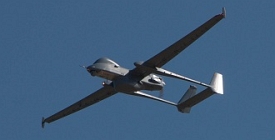
RPAS used for DeSIRE test flights. Photo: courtesy ESA
A key challenge for the future of aviation is the safe integration of Remotely Piloted Aircraft Systems (RPAS) in civil airspace. In preparation for this development, various global organizations are working to draw up procedures for the integration of manned and unmanned air traffic. Besides the practical and technical aspects are also being studied carefully. This spring, the future was brought a step closer when a Heron unmanned aircraft successfully completed a number of test scenarios in Spanish airspace. The tests were conducted as part of the international DeSIRE project (“Demonstration of Satellites enabling the Insertion of RPAS in Europe”). The National Aerospace Laboratory of the Netherlands (NLR) played an important supporting role in this project.
“See and avoid” is one of the main responsibilities of pilots flying passenger aircraft. As RPAS systems do not have human pilots on-board, the principle has been modified to “detect and avoid”. These capabilities were also tested as part of the DeSIRE project.
The Heron aircraft took off from the combined military-civil airport in Murcia in southern Spain and ascended to cruising altitude, whereupon the Barcelona Air Traffic Management Centre took over responsibility for flight coordination via a satellite link with the RPAS pilots on the ground. The ATM Centre transmitted clearances and an air situation picture (from radar) to the RPAS, which in turn transmitted them to the RPAS pilots at Murcia’s San Javier Airport. Because the actual operating conditions may exclude the possibility of a line-of-sight link, all communications took place via satellite link in order to ensure a highly realistic simulation.
To further enhance the level of realism, a CASA-101 training aircraft of the Spanish Air Force performed a number of controlled potential conflicts with the RPAS. The aim was to check if the pilots in Murcia were sufficiently alert in responding to the Barcelona ATM Centre, which closely monitored the potential intersection of the routes of the RPAS and the training aircraft. The pilots performed well in this test.
In addition to the DeSIRE scenario, the interaction between manned and unmanned aircraft was tested in reality when the Heron aircraft was established on approach and unexpectedly had to evade an ambulance flight taking off from Murcia’s San Javier Airport. The RPAS and its pilots also responded appropriately in this situation.
DeSIRE is a collaborative project undertaken by the Spanish electronics giant INDRA, the European Defence Agency (EDA), the European Space Agency (ESA) and AT-One, a strategic ATM (Air Traffic Management) research alliance between NLR’s Air Transport Division and the Institute of Flight Guidance of the German Aerospace Centre (DLR).
In addition to technical and procedural aspects, the tests also examined the suitability of the Heron aircraft or a comparable RPAS for maritime surveillance missions. For this purpose the Synthetic Aperture Radar (SAR) system, the camera systems, and the sensors installed in the body of the robot aircraft were continuously active during the test flights. The RPAS proved capable of detecting and tracking vessels across large stretches of ocean, even if they had switched off their Automatic Identification System (AIS).
The experiences gained through these tests will help the Spanish maritime authorities and their Dutch counterparts in the selection of unmanned maritime patrol aircraft.
Also visit our UAS Human Effectiveness, Remotely Piloted Aircraft (RPA) Regulations, RPAS System Flight Testing and Unmanned Rotorcraft Systems (URS)Â capability pages.


